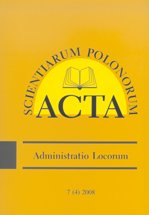Analiza rozwoju Sieradza na podstawie interpretacji zdjęć lotniczych i waloryzacji przestrzeni z wykorzystaniem elementów teorii zbiorów rozmytych
Analysis of the development of the city Sieradz based on the interpretation of aerial imagery and valorisation of the space using elements of fuzzy sets theory
Author(s): Mariola Matuszewska, Krzysztof BędkowskiSubject(s): Human Geography, Sociology
Published by: Wydawnictwo Uniwersytetu Warmińsko-Mazurskiego w Olsztynie
Keywords: remote sensing;urban sprawl;urban and rural way of using space;fuzzy sets;suburban area;suburbanization;multitemporal data;
Summary/Abstract: The spread of cities poses a serious urbanisation and natural challenge and significantly affects the quality of life of the inhabitants. The aim of the study was to examine the possibility of analysing the spread of the city of Sieradz based on the interpretation of multi-temporal aerial imagery from the years 1959, 1996 and 2015, and the topographical object database. There are 22 land cover classes that are attributed with coefficients determining their degree of belonging to the urban use of space. The area of the city is divided into hexagonal primary fields (1 ha) and the proportion of different forms of land use is determined and the M indicator calculated, which determines to what extent each primary field belongs to the urban way of space use. The primary fields were than classified into three zones: urban (0.5 < M ≤ 1.0), transitional (0.3 ≤ M ≤ 0.5) or rural (0 ≤ M < 0.3). Maps of the increment of this indicator in the test periods were made also. In the city there were consistently predominant areas with a rural nature of space use, because Sieradz has a large share of farmland, grassy vegetation, woodland and trees, orchards, plantations and gardens. Over time, however, the city area of typical urban use is increasing, which is mainly in the central and eastern part of the city and is clearly approaching its southern border, confirming the expansion of urban development to peripheral areas. By the year 1996 the growth of the M indicator took place mainly in the central part of the city, and in the next period revealed the clear “islands” of this growth quite distant from the centre. During the period 1959–1996 in Sieradz an early stage of the development of urban sprawl is noticeable – mainly progressive construction near the railway. However, in later years, the increase in accessibility to car transport was the cause of a deeping phenomenon of “urban sprawl” into the peripheral areas, causing a lively development of the suburbs. Studies have shown that urban sprawl also applies to mid-sized cities and confirms the suitability of archive aerial imagery and studies made using fuzzy sets theory to analyse the urban sprawl. The method used is relatively simple to use and can be fully automated.
Journal: Acta Scientiarum Polonorum Administratio Locorum
- Issue Year: 18/2019
- Issue No: 4
- Page Range: 381-395
- Page Count: 15
- Language: Polish

